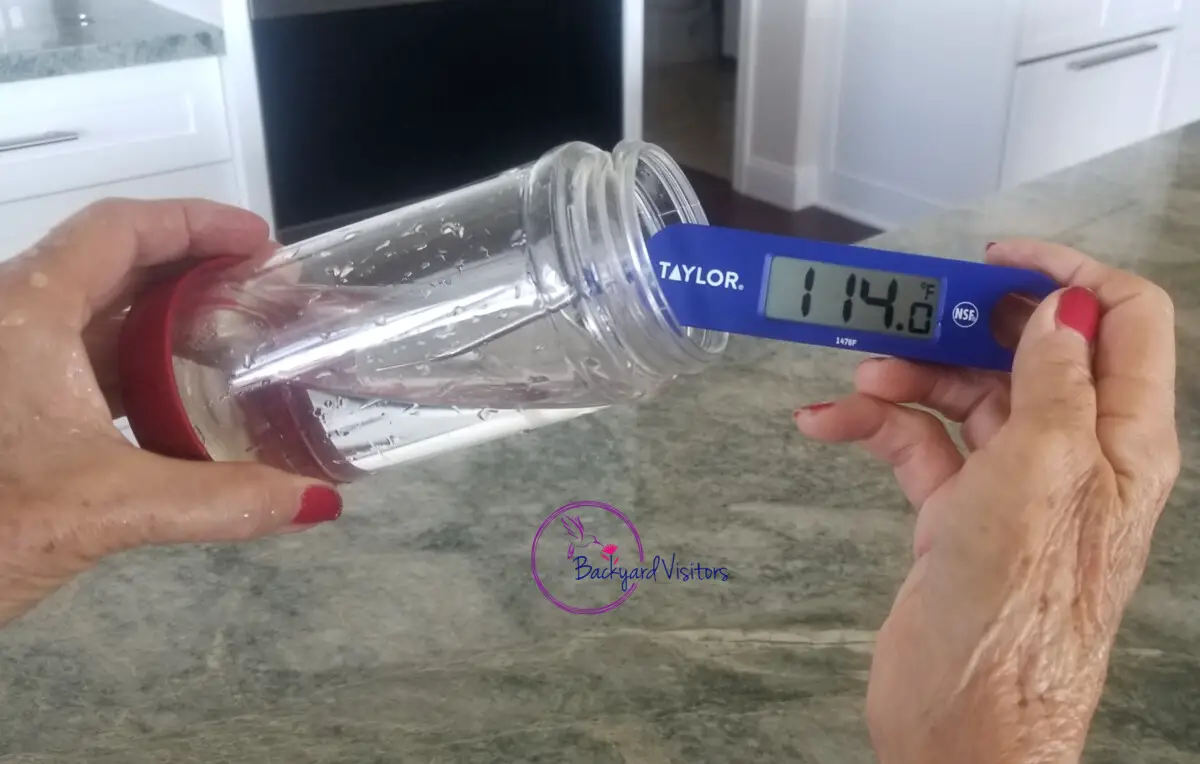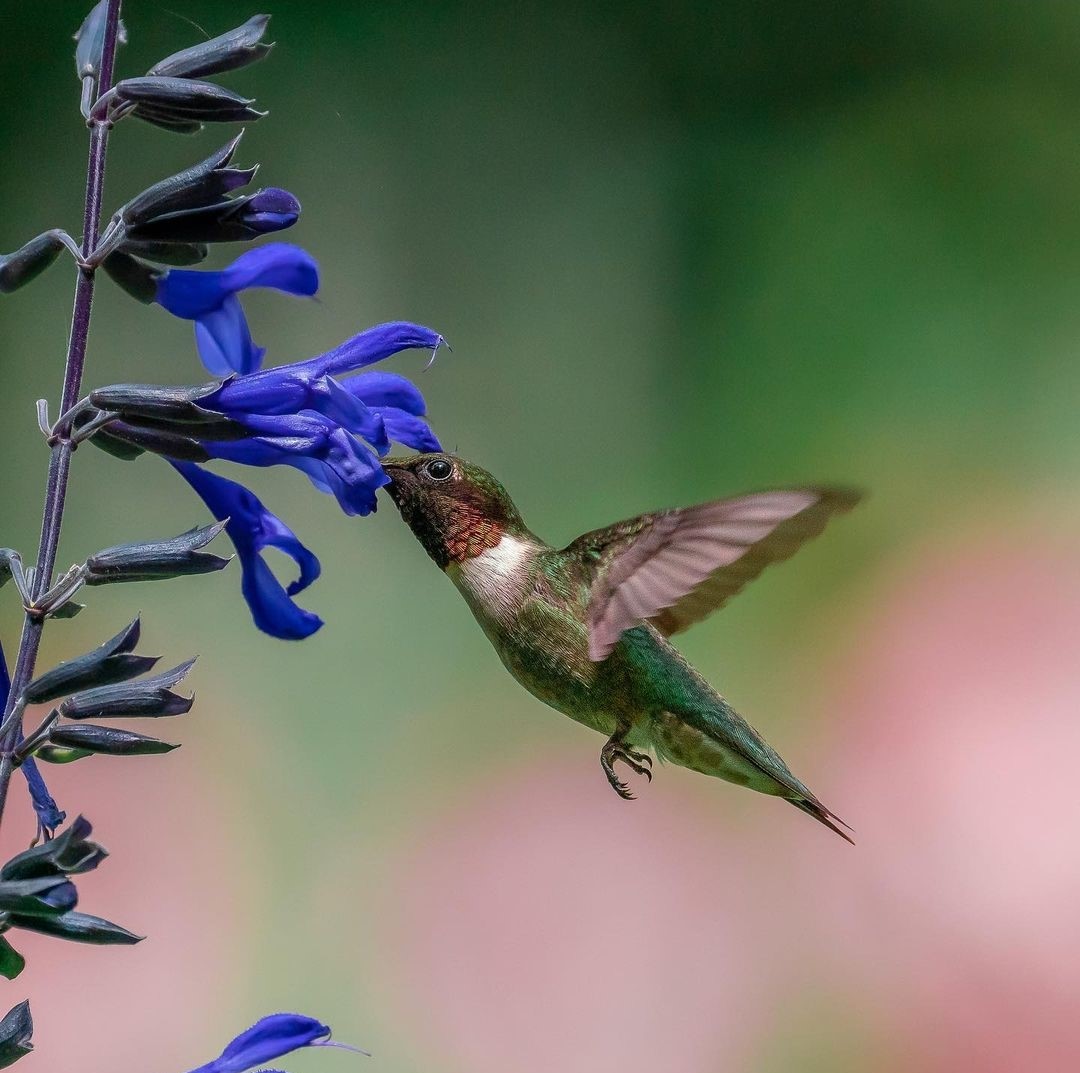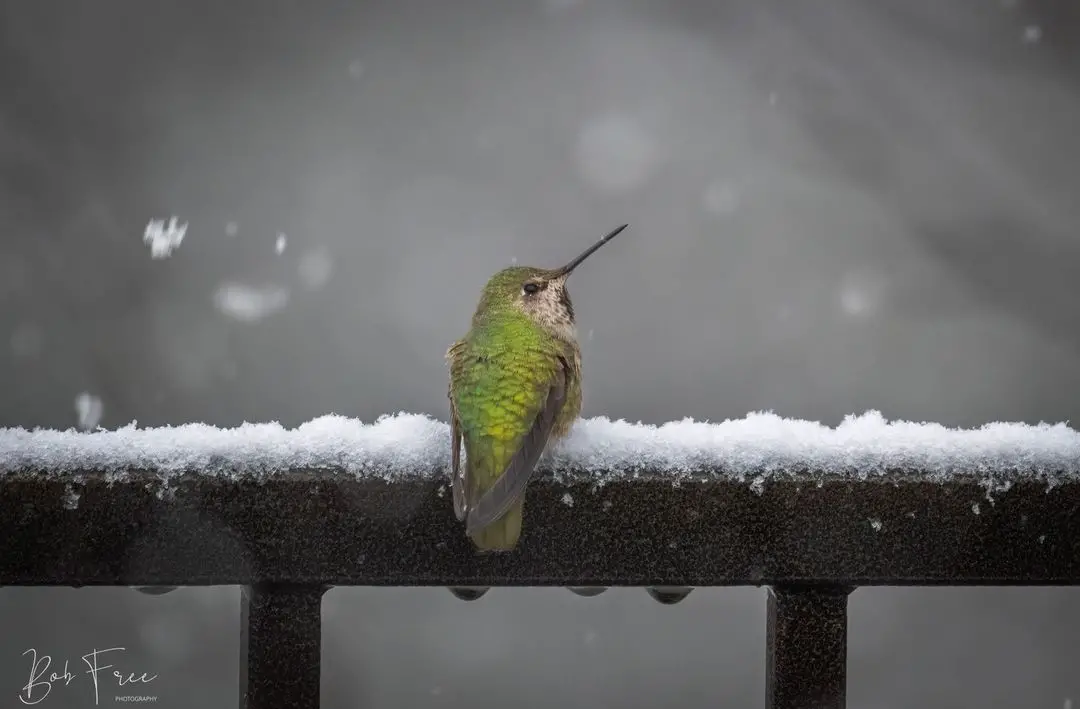This post contains affiliate links.
Discover whether hummingbirds prefer warm or cold nectar. This insightful article delves into the preferences of these fascinating birds and provides tips on how to offer the ideal nectar temperature to attract more hummingbirds to your garden. Learn the science behind their choice and optimize your hummingbird feeders today!
Hummingbirds captivate us with their iridescent plumage glinting in the sunlight and rapid wingbeats. These tiny avian acrobats possess not only an aesthetic appeal but also an intriguing ecological role as pollinators. Beyond their beauty lies a question of practical importance to those who wish to entice them to their gardens.
Do hummingbirds have a nectar temperature preference? In this article, we delve into the thermal preferences of hummingbirds and shed light on how the temperature of their sweet sustenance influences their feeding behavior.
Do Hummingbirds Prefer Warm or Cold Sugar Water?
Avid bird enthusiasts often ponder whether hummingbirds prefer warm or cold nectar. This inquiry pertains particularly to the sugar water provided in hummingbird feeders. Understanding the preferences of these vibrant birds greatly enhances the effectiveness of a hummingbird feeder, enticing more of these delightful creatures to visit one’s garden.
Generally speaking, hummingbirds prefer flowers that have been warmed naturally by the sun, which suggests they lean towards nectar that’s just warm enough to mimic this natural condition.
I was curious one summer when the weather was extraordinarily hot. I watched my local hummingbirds as they struggled to stay cool by perching in the shade and flying through misters that I had set up. I felt sorry for them in their struggles and thought that on hot days, I enjoy consuming a cold drink, so why would my avian jewels not like the same?
I provided them with cold feeder food alongside their warmed feeder food and noticed that as hot as the day was, they gravitated toward the warm feeder in contrast to the cold feeder.
However, feeders left in the sun too long on hot summer days will cause the nectar to become too hot, and eventually ferment.

This feeder was in the sun but the ambient
temperature was in the low 80’s
Read my article:
Should Hummingbird Feeders Be in Sun or Shade? – Feeder Placement Guide for Hummingbirds
It is better not to have your hummingbirds drink very cold nectar on a hot day, as their tiny bodies are highly sensitive to temperature changes. Consuming very cold substances on a hot day could cause cold stun.
When contemplating whether hummingbirds prefer warm or cold sugar water, consider that feeder nectar should ideally be close to the ambient temperature. In the warmth of a sunny day, but not directly in the sun, the nectar in the feeder reaches a temperature that is just warm enough to please the hummingbirds without becoming overly hot since this would deter them or potentially be harmful.
Furthermore, the feeder nectar that hummingbirds consume should not contain preservatives, making it crucial to maintain the nectar at a safe temperature to inhibit bacterial growth. This care ensures the health and safety of the birds partaking in your sugar water offerings.
Read my article: Forget Commercial Hummingbird Food, Try Making Homemade Nectar
When making a sugar water solution for your hummingbird feeder, it is often a good practice to serve it at a temperature similar to what the birds would experience in nature. Therefore, while sweeter nectar draws birds to your site, the temperature of the nectar also plays a pivotal role in attracting these birds to your feeder.
If the nectar is too hot, it will burn the hummingbird’s throat making them unable to continue to consume food. Without the ability to consume nutrition, they eventually die of starvation.
Read my article: How to Cool Hummingbird Nectar in Hot Weather
In essence, while it is essential to replicate the nectar’s natural sweetness – remembering that these birds prefer flowers that offer similar tastes – the temperature is critical for their health and wellbeing.
A good rule of thumb is to aim for warm temperatures equivalent to nectar that has been just kissed by the dawn’s early light. If cool weather is a concern, it is advantageous to offer sugar water that is just warm enough to provide a gentle, inviting warmth for the hummingbirds to enjoy.
When considering if hummingbirds prefer warm or cold nectar, they will show a preference for nectar that is warm, mimicking the safe and natural environment of flowers caressed by sunlight.
Hummingbird aficionados carefully strive for that golden mean, where the nectar is warm enough to appeal to the birds without becoming too hot, ensuring a lively and buzzing hummingbird feeder throughout the season.
Understanding Why Hummingbirds Might Prefer Warm Nectar in Their Diet
When it comes to ascertaining whether hummingbirds prefer warm or cold nectar, it is essential to delve into the intricacies of their dietary habits and the physiological makeup that dictates their preferences.
Many aficionados ponder, do hummingbirds prefer a certain temperature in their sustenance? While it is not a simple yes or no answer, there is compelling evidence to suggest they do, indeed, prefer warm nectar; a predilection arising from multiple aspects of their behavior and environmental interactions.
Hummingbirds are drawn to the vibrancy of flowers and also to their thermal qualities. Flowers warmed naturally by the sun provide a nurturing source of warmth for these birds, optimizing not just the nectar’s viscosity for easier consumption but also aligning closely with their high body temperature.

absorbs the sun’s heat
keeping the nectar warm
The concept of warmer nectar being the choice ties back to the birds’ incredible metabolic rates. As these creatures imbibe nourishment, their minute bodies crave energy-efficient sources and warm nectar is less taxing to process.
In their relentless quest for sustenance, these birds exhibit a remarkable nectar takedown. The feeding habits of hummingbirds are fine-tuned to the optimal conditions under which nectar is extracted swiftly and efficiently.
Likewise, their preference leans towards warmth. Observations suggest that hummingbirds gravitate towards food sources that provide them with an edge – a warmer substance facilitates a quicker energy transfer, a critical element for birds that live life in the fast lane.
The question of whether birds favor warmth over cold is not lost on those tending to hummingbird feeders. The contents of these feeders benefit from exposure to the sun, emulating the natural warming effect.
By understanding that hummingbirds prefer flowers and feeders akin to those warmed naturally by the sun, enthusiasts can enhance their backyard habitat, drawing in these feathery guests with strategically placed feeders that catch the sun’s warming rays.
Empirical observations underscore the notion that warmer nectar is appealing to hummingbirds. This is not merely a trend but a clear preference. The fact that warm nectar lessens the energy expenditure for these energetic birds gives a strong hint towards an affirmative answer to “Does Hummingbird prefer warmer nectar?”
In the grand scheme of nature’s complexities, it is certainly plausible that the warmth of nectar is an underestimated yet pivotal player in the survival and thriving of these entrancing birds.
As enthusiasts continue to ponder and study the feeding habits and food sources of these vibrant birds, ensuring the provision of an environment that mimics their natural preferences is key. While cold nectar will not be shunned, the alleys and anecdotes of hummingbird aficionados whisper the tales of warmer nectar being the subtle secret to a bustling garden of hummingbirds.
How Cold Nectar Affects Hummingbirds’ Preferences and Feeding Habits
When exploring the dietary proclivities of these avians, we often encounter the question, do hummingbirds prefer their nectar warm or cool? It is a point of intrigue for many enthusiasts aiming to optimize their garden offerings.
To understand this preference, we must evaluate how cold nectar impacts these birds, considering their high metabolic rate and need for continuous energy. It is no secret that hummingbirds prefer a consistent energy source. The cold nectar significantly affects their ability to maintain body temperature and energy levels.
Hummingbirds, with their rapid wing beats and ceaseless activity, have body temperatures that soar above the ambient air. Consequently, super cold nectar is less enticing since it requires more energy for the birds to bring it up to body temperature—a valuable resource they need to save, especially when other food sources are not as readily available.
They prefer warm nectar, which more closely aligns with their internal temperature, thus minimizing the energy spent on thermoregulation.
Sugar water, resembling the natural consistency of nectar from flowers, is a preferred feeder choice. However, its temperature plays a pivotal role in its attractiveness to hummingbirds.
As ambient temperatures dip, nectar consumption rates decline if the sugar water becomes too cold, potentially driving hummingbirds to seek out alternative food sources that demand less physiological effort.
Ultimately, while they will still consume the cold offerings, efficiency dictates a leaning towards sources that will not lower their body temperature.
The thermal aspect of hummingbird feeding habits is not purely about preference but survival. During colder weather, hummingbirds must effectively manage their calorie intake against energy expenditure. A chill in the air necessitates a strategic approach to nectar consumption, balancing the natural desire for sweet sustenance with the physical cost it imposes.

It is this delicate equilibrium that shapes not only the hummingbirds’ preference for sugar water but their broader foraging behavior in cooler climates. Monitoring these delightful creatures’ nectar preferences thus enhances our understanding of their ecological needs and how adaptive measures play out seasonally.
Read my article:
How to Help Hummingbirds in Cold Weather
To cater to hummingbirds effectively, aligning with their predilections increases visitations to your feeder. Offering sugar water that does not plunge into the extremes of super-cold nectar makes a significant difference in their daily routine.
By managing feeder sun exposure and temperature, avian enthusiasts will ensure a consistent and inviting food source, fostering an ideal environment conducive to the spectacle of hummingbirds in graceful flight. By crafting this optimal feeding scenario, we become not just observers but participants in the sustenance of one of nature’s most enchanting birds, hummingbirds.
Read my article:
Should Hummingbird Feeders Be in Sun or Shade? – Feeder Placement Guide for Hummingbirds
Exploring If Hummingbirds Like Cold Sugar Water During Different Seasons
As a hummingbird aficionado, it is captivating to ponder whether these vibrant birds display a preference for the temperature of their sustenance. Do hummingbirds prefer warm or cold nectar?
Intriguingly, hummingbirds’ nectar preferences are not static; they fluctuate with the change of seasons. Are these agile creatures more inclined to savor cold nectar or do they tend to seek out sources that mimic the tepidness of flowers bathed in sunlight?
During spring and summer, when the climate is warmer, one might surmise that cold sugar water offers a refreshing respite for the birds. However, the reality is that hummingbirds prefer warmth to mirror natural conditions.
Their high metabolic rates are indicative of their preference for warmth, suggesting that even in hot weather, hummingbirds will not opt for cold sugar water as readily as one would assume. A hummingbird hovering in a garden filled with sun-kissed blossoms is naturally accustomed to nectar that has been warmed by the sun’s rays.
On the flip side, as we transition into the cooler months, it is reasonable to question whether these birds would welcome a cooler option. The evidence leans heavily towards the fact that hummingbirds prefer warm nectar regardless of the chill in the air.
The preference for warm nectar, even when faced with cold, highlights their need for quick energy that is rapidly absorbed, considering their high metabolic demands, especially in cold weather.
Warm sugar water that closely mimics natural nectar conditions and provides an immediate source of energy, is essential for their survival in the ever-fluctuating temperatures across different seasons.
The topic of nectar temperature extends into the realm of feeder maintenance as well. It is important to takedown and clean the feeders regularly as part of a maintenance program. This ensures that the sugar water is not only at a desirable temperature but also fresh and free from contaminants, and the feeder is free of black mold.

on the yellow part of the flower.
Read my article: What is the Black Stuff on my Hummingbird Feeder?
Such attention helps in maintaining the bird’s health and preserves their feeding habits, which consists of frequent stops throughout the day.
Ultimately, when one asks “Do hummingbirds like cold nectar?”, the consensus is that these birds have a definitive partiality for nectar that is not cold. They innately seek out warmth, even if it means bypassing a cooler option that might seem appealing in times with hot temperatures.
The warmth not only aids in their digestion but also aligns with the bird’s adapted natural conditions. Consequently, when setting out feeders, providing warm, or at least room temperature sugar water, aligns with the hummingbirds’ preference and mirrors the natural warmth of nectar found in the wild, thereby supporting the spirited lifestyle of these extraordinary birds.
Check out my other posts on Hummingbird Questions
Frequently Asked Questions
Q: Do hummingbirds prefer warm or cold nectar?
A: Hummingbirds show a clear preference for warm nectar, which mimics the natural condition of flowers warmed by the sun. This preference is tied to their physiology and the need for efficient energy absorption due to their high metabolic rate.
Q: Can very cold nectar be harmful to hummingbirds?
A: Very cold nectar will shock their system due to their tiny and highly temperature-sensitive bodies. Therefore, it is advisable not to serve very cold nectar, especially since it could affect their energy maintenance.
Q: What is the ideal temperature for the nectar in hummingbird feeders?
A: The ideal temperature for hummingbird feeder nectar is close to ambient temperature, or slightly warm as if it were heated by the morning sun. This prevents it from becoming too hot, which is detrimental to the hummingbirds and will also promote bacterial growth in the nectar.
Q: How does the temperature of nectar affect hummingbird feeding behavior?
A: The temperature of nectar influences how often and how much hummingbirds feed. Warm nectar is easier for them to digest and provides a quick source of energy, which is vital for their high metabolism, making it more attractive than cold nectar.
Q: Should the sugar water in hummingbird feeders be changed with the seasons?
A: While the temperature of sugar water should consistently mimic natural nectar warmed by sunlight, in cooler seasons, ensuring that the nectar is not cold becomes even more critical. Maintaining room temperature or slightly warm nectar will encourage hummingbirds to continue visiting your feeder year-round.
Happy Hummingbird Watching!
Backyard Visitors participates in affiliate programs which compensate us for referring traffic.

